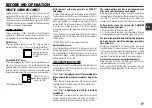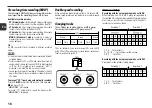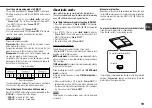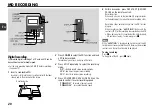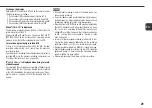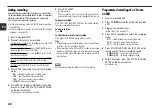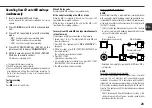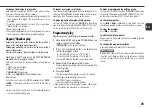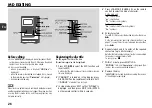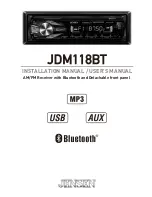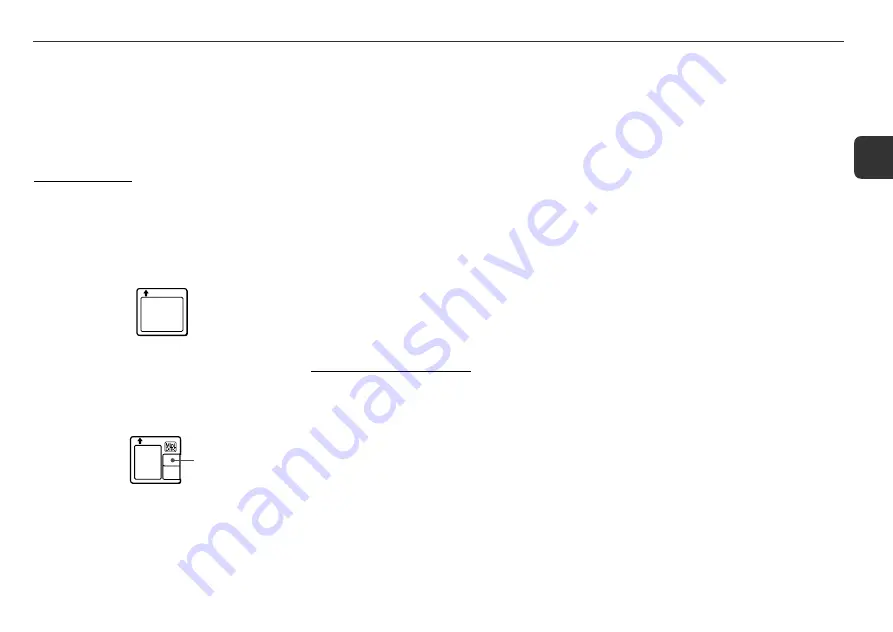
17
En
BEFORE MD OPERATION
WHAT IS A MINI DISC (MD)?
An MD is only 64 mm in diameter, about half the size of a
conventional CD. Unlike a CD, an MD comes in a plastic
cartridge, so that it can be handled with ease. The cartridge
also protects the disc inside from shocks, dust and scratches.
Unlike cassette tapes, which can become stretched or tangled,
an MD is an excellent durable media.
TYPES OF MDS
There are two types of MDs: "Optical discs" and "Magneto-
optical discs". Both types use laser beams and optical pick-
up technology to read recorded data during playback.
Optical discs
These are playback only discs. Like CDs, they are used as
prerecorded music discs. You cannot record or edit them.
Recordable MO*
1
discs
These are recordable discs which can be recorded on again
and again, like cassette tapes. The recording method called
magneto-optical technology employs a laser and magnetism
to record signals. Therefore, the quality of recorded sound
does not deteriorate even after many playbacks and recordings.
*
1
MO: Magneto Optical
Ultra compact size made possible by ATRAC*
2
technology
A digital audio compression technology called the ATRAC
system automatically extracts only the frequencies that are
actually audible to the human ear and cuts the frequencies
which are inaudible. This compresses the amount of data to
be recorded to 1/5 of the normal amount. The ATRAC system
is based upon studies carried out in the field of auditory
psychology and does not impair the quality of the audible
sound.
This unit supports a newly developed ATRAC3 system, whose
compression rate is much higher than that of the conventional
ATRAC system.
*
2
ATRAC: Adaptive TRansform Acoustic Coding
Quick random access
One of the great features of the MD is that you can search for
desired tracks quickly. There are also quick and easy functions
for random playback, in which the order of the tracks can be
rearranged at random, and for renumbering tracks enabling
them to be played in any order.
THE LIMITATIONS OF MD
Recording on the MD is performed differently from that of a
cassette tape or a DAT. Therefore, the MD system is subject to
the following restrictions.
"
Toc* FULL
" is displayed even if the recording time
does not reach the maximum recordable time of the
disc
"
Toc* FULL
" is displayed when 254 tracks are already
recorded on a disc, without respect to the recording time.
* TOC: Table Of Contents
"
Toc* FULL
" is displayed even if a disc is not fully
recorded on
If there are lots of emphasis data in a particular track, the unit
handles the data as index codes, and tracks are counted, in
addition, without respect to the time and number of tracks.
The remaining time on a disc is not increased even
after some short tracks have been erased
When the remaining time on a disc is displayed, it may not be
increased even after erasing short tracks because the sections
less than (12 seconds:standard-stereo (SP) mode / 24
seconds: LP2 mode / 48 seconds: LP4 mode) are not counted.
Certain tracks cannot be joined (the COMBINE
function does not function)
•Tracks created by editing may not be joined.
•It is not possible to combine a track recorded in different
recording modes (monaural, standard-stereo, LP2 and LP4).
The total of the recorded time and the remaining time
on a disc does not match the maximum recordable
time of the disc
Recording is performed in a minimum unit of one cluster
(standard-stereo (SP) mode: 2 seconds / LP2 mode: 4 seconds
/ LP4 mode: 8 seconds). Even if the recorded section is shorter
than this minimum unit time, the time space is needed in
recording. Therefore, the available time becomes shorter.
Track numbers may not be registered properly
When recording from a CD in digital, small tracks may be
created depending on the contents of a CD.
When using the AUTO MARK mode, track numbers may not
be registered properly depending on the contents of the CD.
The shutter covers the
opening only on the
non-labeled side of
the MD.
The shutter covers
the opening on both
sides of the MD.















